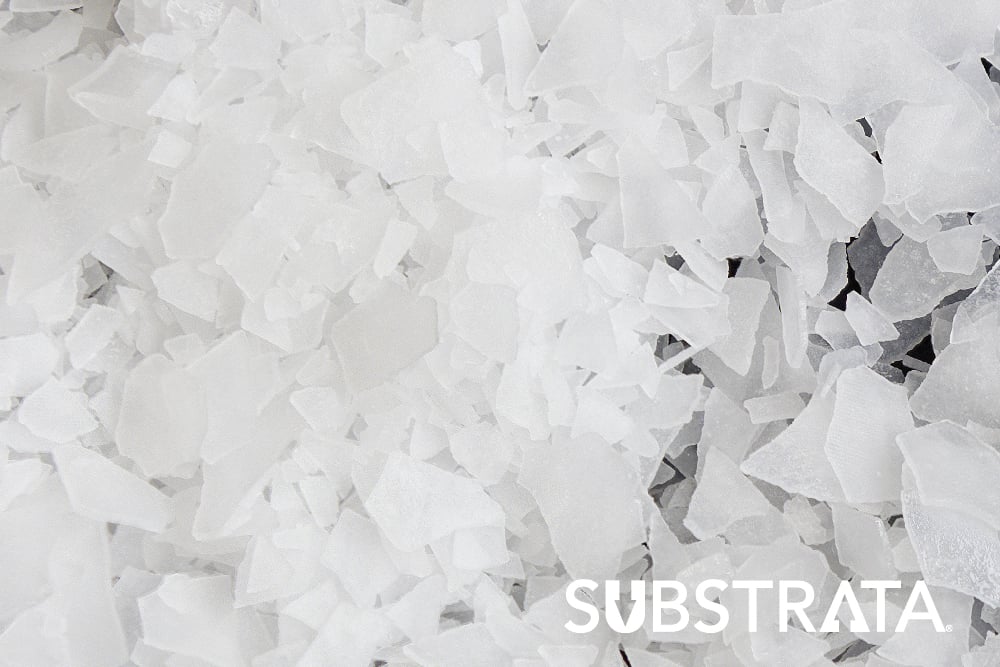
Magnesium chloride is a dust control solution, road deicer, and soil stabilizer. Many county governments use it on both paved and unpaved roads, but it does have drawbacks.
Let’s explore what magnesium chloride is, what it’s used for, how to apply it, and its downsides like costly reapplications and environmental damage.
Magnesium chloride is a salt compound. You might hear people call it mag chloride or its chemical name, MgCl₂. (That just means each mag chloride particle is made from one magnesium ion and two chloride ions.) Mag chloride is available in liquid and solid forms, including pellets and flakes. The treatment works with virtually any soil type.
People use magnesium chloride as a road treatment to control dust, stabilize soil, and de-ice surfaces. It’s especially popular on unpaved roads.
Unpaved roads are very common, accounting for a whopping 32% of U.S. public roads in 2020.1 That’s because they’re often more cost-effective than paved roads. They’re cheaper to construct and maintain, and they’re suited for low-traffic areas.
However, improper maintenance can lead to dangerous driving conditions like potholes, ruts, and excessive road dust. To combat these issues, many people use magnesium chloride as a dust suppressant, road stabilizer, and deicer.
Magnesium chloride is hygroscopic, meaning it pulls moisture from the air. That keeps roads damp much longer than water alone, lowering the amount of dust that comes off the road. It also creates a moisture barrier that bonds the soil particles together, preventing them from coming off the ground.
Magnesium chloride resists evaporation, so a single application can last for three to six months. However, it needs regular reapplications over time, making it only a temporary dust control solution.
Magnesium chloride bonds dirt particles together, creating a hard surface that gives the road stability. The particles bond because mag chloride's hygroscopic nature pulls moisture out of the air and makes them stick together.
Unpaved roads harden as the magnesium chloride penetrates the surface. However, since mag chloride relies on moisture that’s already in the air, it’s not ideal for hot, dry climates with low moisture.
Mag chloride is a popular road deicer. It melts ice quickly by pulling moisture from the ice—and since ice is made of water, it disappears when its moisture’s gone. Mag chloride also lowers the freezing point of water, helping keep the road from refreezing later.
Some people confuse magnesium chloride with rock salt, which is sodium chloride. They’re both salt, but they’re not the same. Mag chloride works in negative Fahrenheit temperatures (something rock salt won’t do), and it works faster than rock salt. That makes MgCl2 more effective for higher traffic roads.
To apply magnesium chloride, one should first grade the roads one plans to treat. Grading ensures the road is smooth and ready to absorb water.
Next, use a water truck to wet the road. This lets the magnesium chloride penetrate the soil instead of staying on the surface. Finally, apply the mag chloride to the damp road. You can use a tanker truck to spray liquid mag chloride, or use a truck with a spinner attachment to disperse solid flakes or pellets. Some counties mix liquid and solid mag chloride for more effective road treatment.
Magnesium chloride starts working immediately, so it should begin to produce results during application.
While MgCl2 is an effective dust control and soil stabilization method, it has drawbacks:
As we mentioned before, road managers must continuously reapply magnesium chloride, as it wears down. This increases maintenance costs over time.
Costs vary greatly by geography, location, type of magnesium chloride, and use. Generally, liquid magnesium chloride deicer averages $0.50 to $2.50 per gallon.2 For dust control, one application typically costs over $10,300 per mile of road.
Imagine Soil County treats 20 miles of unpaved public roads with magnesium chloride twice a year for dust control. Here’s how that adds up:

In 10 years, Soil County would spend $4.1 million on magnesium chloride road treatments for dust control alone—if prices didn’t increase.
Deicing is also costly. Since road commissions must apply magnesium chloride road salt before each snow, many counties and cities only deice a few roads. Before a 2016 snowstorm, Portland, Oregon, treated 518 miles of streets with 10,000 gallons of mag chloride—covering only about 25% of the city’s public roads.3,4
Some counties offset reapplication costs by not treating the road’s full width or by asking residents to pay for treatments on county-owned roads.
There’s a lot of debate about magnesium chloride’s environmental impact, so let’s start by looking at both sides.
Some people say magnesium chloride is environmentally safe. After all, it’s a naturally occurring compound. The Environmental Protection Agency (EPA) approved it, and the U.S. Forest Service uses it. Companies also use it to meet PM-10 regulations, which require suppressing tiny, inhalable dust particles to protect people’s respiratory health. That all sounds good so far.
However, others say magnesium chloride is only safe if you can keep it on the road—which is almost impossible. It easily washes off with rain and snowmelt. It then leeches into surrounding soil and groundwater. Like all salt compounds, magnesium chloride builds up in soil and water over time. People believe that build-up eventually harms the environment, and studies on mag chloride support this belief.
Research shows that highly concentrated magnesium chloride makes water unsafe to drink, harms aquatic wildlife, and keeps plants from effectively absorbing water and nutrients. Colorado State University found that magnesium chloride is especially tough on plants downhill from treated areas. Plants need both magnesium and chloride to grow, but too much of either is unhealthy. Their roots absorb magnesium chloride from the soil and take it through their water-conducting systems. It then builds up in their leaves, weakening or killing them. Vegetation affected by magnesium chloride exhibits leaf scorching, marginal necrosis, needle tip burn, and stunted growth.7
Magnesium chloride’s negative environmental impact is easy to overlook because it happens slowly over time. A winter deicing treatment won’t affect plants immediately because they aren’t actively growing then. The impact happens months or years later. To that end, some counties have banned magnesium chloride, and some states like Montana are reducing its use.
Another drawback is magnesium chloride's corrosive nature. Some people claim it’s less corrosive than rock salt, but studies show that the two can be equally corrosive.5 Magnesium chloride eats away at metal, meaning it damages metal components of bridges and cars driving on treated roads.
Magnesium chloride specifically corrodes vehicles’ undercarriages, putting brake lines, ball joints, wheel bearings, and other essential parts at risk. It even erodes wiring harnesses and causes electrical problems.
There is no fixing corrosion; there’s only the option of replacing ruined parts, which quickly gets expensive. The trucking industry alone spends an estimated $2.4 to $4 billion annually for repairs due to magnesium chloride road treatments.6
Corrosion damage is almost impossible to prevent. To effectively prevent corrosion, people must wash their vehicle’s undercarriage immediately after driving on treated roads. However, that’s virtually impossible in freezing weather. In summer, they’d leave the car wash only to drive home on the same roads, defeating the purpose.
There’s a reason cars in states that use mag chloride heavily are so rusty! And adding a rust inhibitor to liquid magnesium chloride? That’ll cost you extra.
While magnesium chloride treatments work on any type of soil, they’re most effective in high-humidity climates with moist air.
Magnesium chloride is less effective (or ineffective) in dry climates with low humidity and soil moisture content. In fact, trying to use mag chloride in low-moisture areas can dry out the soil, rendering the treatment useless, creating more dust, and making the surface unstable.
Magnesium chloride is an effective dust suppressant, soil stabilizer, and deicer. It’s simple to apply. However, it has some serious drawbacks, including:
While many counties still use magnesium chloride, you can find affordable, effective, and eco-friendly alternatives.
These Stories on Soil stabilization
No Comments Yet
Let us know what you think